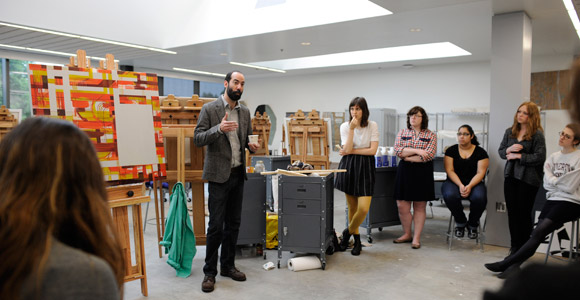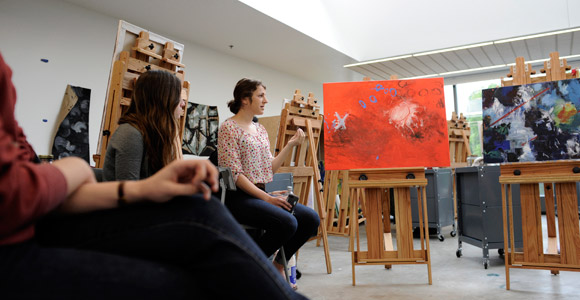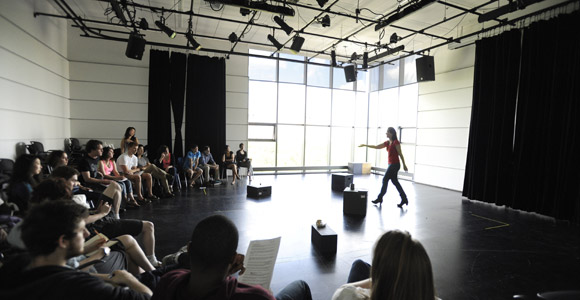
Logan Revealed
During the new arts center’s get-acquainted period, painting and performance students were quick to make it their own.
by Laura Demanski, AM’94 | photography by Chris Kirzeder
The new Reva and David Logan Center for the Arts won’t open officially until October 11, but this spring it was buzzing. While some of the building’s details awaited finishing touches, the doors swung wide in late March for a preview period that was packed with activity: art exhibits, plays, a Friday night cabaret series, an “Arts Apocalypse,” and 37 undergraduate and graduate courses. The Core visited two of the classes to see how students and teachers were breaking in the building, with its 170-foot tower overlooking Hyde Park from the southwest corner of campus.
COURSE: PAINTING
INSTRUCTOR: DAVID SCHUTTER
LOCATION: PAINTING CLASSROOM 203
By the time assistant professor of visual arts David Schutter’s painting class begins at 10:30 a.m., a clutch of students is already at work in the spacious studio. They paint, chat, and lean back to study each other’s work and offer opinions. On new wooden H-frame easels rest their current paintings—the second of three they’ll each complete over spring quarter, along with several 20-minute exercises. “Our easels at Midway Studios”—where most visual arts classes were held prior to this quarter—“were three metal poles,” notes a fourth-year. The lockable carts where students store their supplies and rest their palettes are another welcome upgrade.
It’s the first really warm day of spring, balmy but overcast. Still, the sheer number of windows in the studio’s west and north walls means there’s ample light, filtered through leafy treetops. It’s hard to believe that this room has been in use for only six weeks, it feels so lived-in. And it is, in a sense—this is the only class held there this quarter, so the studio is available to the students any time Logan is open (with a UChicago ID, 8:00 a.m. to midnight six days a week, 11:00 a.m. to 8:00 p.m. on Sundays). They are taking advantage of the privilege. Studies and sketches paper the floor; if you’re not careful, you might inadvertently trample art. Carts and easels, placed and angled to meet students’ personal preferences, render the room a maze.
Navigating the colorful warren, Schutter makes the rounds. For the current project, he’s assigned each student an idiom—“all hat, no cattle” or “between a rock and a hard place,” for instance. The idea is to express the concept behind the idiom, substituting oil paint on canvas for the metaphorical language used in the figure of speech. Painting, say, a cow or a cliff face would be a mistake. Instead, Schutter wants the students to “stretch the conceptual threads” underlying their idioms as far as they can. “The idiom is just a prompt,” he says. “In the end we’ll only have the painting.”
He and the teaching assistant, Clare Rosean, MFA’12, work their way around the room, drawing students out about the decisions they’ve made and talking through the visual effects of their choices. Schutter—whose own work as an artist records his responses to masters of his medium like the 19th-century English painter John Constable—locates the students’ work in relation to well-known artists he perceives as doing similar things in their painting. On two sheets of butcher paper hanging in the studio, he lists each student’s name and the names of artists he wants them to study on their own time. He changes up the latter frequently based on what he sees in the evolution of the student’s work. His one-on-one consultations reward eavesdropping:

Student 1: “Could I add something three-dimensional?”
Schutter: “With oil you can’t really do that. With polymers or acrylics, you can, but oil painting is a very purist activity. You can add sand or phosphate to build up the paint, but basically it doesn’t want to be disturbed. See Frank Auerbach—his paintings are built up, and they’re often displayed in a glass box because people are so tempted to touch the paint.”
Schutter: “You’re going to be co-opted by the world soon enough. You might as well develop some autonomy. This seems timid.”
Student 2, painting “knock on wood”: “I feel like I’m not painting anything. I like abstraction, but I feel like I’m not painting anything.”
Schutter: “When we did still lifes, you were painting almost abstractly. Now that we’re painting abstractly, you feel timid.”
Student 2: “I have the words, but I’d like something visual to work from.”
Schutter: “You can use anything in this room as a prompt. If you need to use observational painting, bring it into the mind’s eye.”
Student 3: “I like this one better.”
Schutter: “What are the criteria for liking? You have to stop merely liking.”
Student 3: “Valley girls would be really hard up then.”
Student 4, painting “kick the bucket”: “I’m trying to convey the creation of distance, but I don’t know if I’m doing it at all.”
Schutter: “It looks like you’re in the middle ground, really keyed in to the effects of the brush. This is the zone of the transfigural: something is turning into something else. But the change is minimal. I have to slow down my expectation of discovery, recalibrate my expectations. That’s really profound. It’s not quite there yet, but it has an anatomy and a mind.”
Student 4: “Thank you.”
Schutter: “OK.”
Schutter: “Your preliminary sketch has similar elements to your painting, but feels more in command, more swiftly done. Maybe in painting on canvas you have a tendency to fuss.”
Student 5, painting “mad as a hatter”: “I’m not sure how to undo that this late in the process ...”
Schutter: “Your questions are all valid, but there’s no answer to them. You just need to roll up your sleeves and press forward.”
When class breaks up, Schutter sends students off with a directive: “I need you to have a new canvas next class. We’ll hold a critique, but be ready with a new canvas. All I can tell you is that it will be a portrait of some kind, no smaller than what you’re doing now.”
The rainy morning of the critique, the class feels more subdued. Sweatshirts, jean jackets, and umbrellas are ubiquitous. Normally the group migrates to the empty gray hall outside the studio for critiques, but today a different class has claimed the space. A few students pitch in and help Schutter create a small clearing before three easels. Class members sit on stools or on the floor, stand, or lean on something. At Schutter’s request, three students place their idiom paintings on the empty easels.
Schutter, in a button-down shirt and tweedy gray jacket, begins: “By now you have a good formal vocabulary, so let’s spend today breaking these down formally. What’s the subterranean subjectivity of these things?” He gestures toward two of the first three canvases on display. “Here are two paintings with completely different strategies, but that do something similar. They’re alike and not alike.” What follows feels less like critique than close reading.
One painting is by a yellow-stockinged student named Claire. Responding to the idiom “close but no cigar,” she’s put down a layer of even gray, placed masking tape over it in a rectilinear arrangement, painted an abstract geometric pattern of yellows, oranges, and browns, then stripped off the tape. This leaves an irregular grid of clean gray, or nearly so—bits of pattern cross over onto the gray in places, complicating the relationship between negative and positive space. The distinction between background and foreground is close, the class decides, but no cigar.
“Also,” Schutter asks, “what does the pattern look like?” “Guitar strings,” ventures one student. “A computer switchboard,” another chimes in. Heads nod, and John, one of two men taking the class, qualifies the group’s consensus: “It’s hard to think of a motherboard because of the color palette, which is like grandma’s upholstery. It’s hard to tell what’s really background.”
“It refuses or resists completion,” agrees Schutter. “There are three things: the gray, the fretwork, and the overlap. Can you see how there’s kind of a stutter step between the rectangle with pattern in it and the gray rectangle? The eye moves back and forth. The pattern bears infinite analysis while the gray has a sheen that reflects back.” Following a brief gloss of Lacanian theory of the mirror and the void, the class moves onto similarly intricate analyses of the other two paintings, then two more groupings of three.
Discussion ranges widely, from shapes and objects evoked by the paintings—cells, ghostly headphones, the McDonald’s character Grimace, Greek and Roman flooring patterns, the state of Louisiana—to art history and cultural theory. Schutter presses students to connect their interpretations and responses to specific features of the paintings, asking them to get up and point when necessary. Artists invoked include Lucian Freud, Nicolas Poussin, Peter Paul Rubens, Ad Reinhardt, Philip Guston, and the ancient Greek mimetic master Zeuxis, who painted grapes so realistic, birds pecked the canvas trying to eat them.
When the final trio of pictures goes up, the group grows collectively transfixed by John’s painting. Shapes and scrawls of white, black, and blue adorn a bright orange-red, thickly painted background, like primal graffiti. John’s prompt was “icing on the cake.”
“This is right out of Cy Twombly,” says Schutter. “Do you know him? Look him up. There’s always a myth behind his paintings. This painting somewhat does what the idiom does. Sometimes the title doesn’t clarify a painting, but underlines it.” Claire, whose masking-tape painting was the first one up for discussion, addresses John directly: “I feel like you were working something out, and paint was just what happened to be around—it was the material at hand.”
Schutter nods thoughtfully. “To me, that is the highest compliment you can give to a painting: to say it’s like physical thinking. To say you were working out a philosophical problem in paint.” He looks at the picture again. “It’s luminous.”

COURSE: STAGING DESIRE
INSTRUCTOR: HEIDI COLEMAN
LOCATION: PERFORMANCE LAB 501
Heidi Coleman, director of the program in Theater and Performance Studies, commands attention. Teaching a course about performance, Coleman models compelling performance—staying in motion, projecting her voice, posing crisp questions. This Thursday afternoon, her opening line cuts clean through students’ chatter about jar sharks (Internet meme or real thing?) and homework: “What makes a good party?”
The responses: food, drinks, music, swag, “Put it on the roof!” Coleman’s question is practical; she’s planning an event, Arts Apocalypse, which she hopes will draw 1,000 people to the Logan Center two Saturdays from today. When she puts it a different way, the question is one that also underlies the course she’s teaching: “How do you create an audience experience?”
Text and Performance: Staging Desire, which fulfills the Core curriculum requirement of one to two courses in the dramatic, visual, or musical arts, is the first class ever to be held in Logan 501. The room, a “performance lab,” is outfitted with a sophisticated sound system, stage lighting, and blackout curtains. When the curtains are open, the room’s dramatically tall windows offer a vista on campus to the north; to the east, you can see as far as Lake Michigan. Coleman’s syllabus makes clear that the lab’s amenities are not to be squandered: “A minimum of three hours of rehearsal in preparation for presentation is expected … Scenes should be rehearsed in the Performance Lab as my expectation is they are fully staged with lights and using architecture.”
After a quick warm-up exercise, the room is loose. The teacher and several students have kicked off their shoes. Coleman calls out, “Count off by fours.” Four groups form, about five students each. The assignment: in 15 minutes, figure out how to demonstrate the five elements of temporality—gesture, tempo, repetition, duration, kinesthetic response—in a scene from Sexing the Cherry.
The 1989 Jeanette Winterson book, a historical novel in postmodern style, is one of the primary texts on the syllabus, along with Angels in America (students must attend the production at Court Theatre a few blocks away), the script of Caryl Churchill’s play Cloud Nine, Bram Stoker’s 1897 novel Dracula, Christina Rossetti’s 1862 narrative poem “Goblin Market,” and the popular movies Dirty Dancing and Say Anything.
When 13 minutes have passed, Coleman closes the curtains and turns on the stage lights. Two groups perform before the class pauses to talk. Two more groups go, followed by more analysis. The discussion circles around the performance, the text, and class readings about desire, romance, and spectacle.
A few times, Coleman summons students back to the stage. “Do it again, twice as fast,” she tells one group. She’s right; their performance gains energy. In another scene, two people eating dinner are rounded up and marched away by armed men. Coleman asks for a redo with the casting switched. The white men who originally carried the guns sit at the table, while the Asian American man and woman become the intruders. “The scene is not about internment anymore,” notes Coleman.
The following Tuesday, there are more scenes from Sexing the Cherry, but this time prepared and rehearsed outside of class. These performances include costumes, set design, and props. One scene employs a simple stylized set. When it begins, the room is dim and four people stand very still on boxes, bundled up in white sheets, backlit, and whispering. A dancer coaxes them down and unwinds them from their wrapping one by one. The effect is haunting and hopeful.
Afterward, the spectators critique. “All I could think of was cocoons,” offers one student. “Did anyone feel sad?” asks Coleman. “These people who aren’t dancers dancing, moving. But you needed to further articulate the lighting on the statues, to figure out how to design space without time in which people can dance.”
In contrast, the other scene has lots to look at: a giant die, shaving cream, a pineapple, a giant chocolate bar. But none of these constitute the visual centerpiece. A few minutes into one scene, someone suddenly draws open the lab’s curtains to reveal an actress perched high on a window grid in the corner, silhouetted against the leaves and limestone of campus. In discussion afterward, this “big reveal” is the first thing the class wants to talk about. “It wouldn’t have been the same if we had seen her up there from the beginning,” Coleman notes. “Revelation works every time.”
